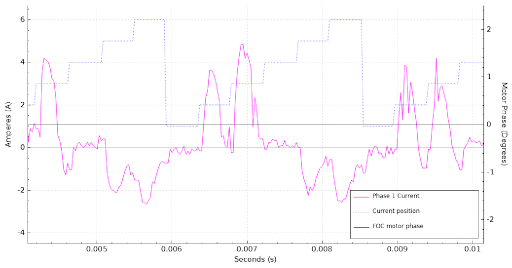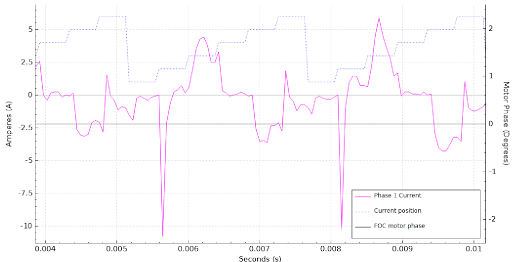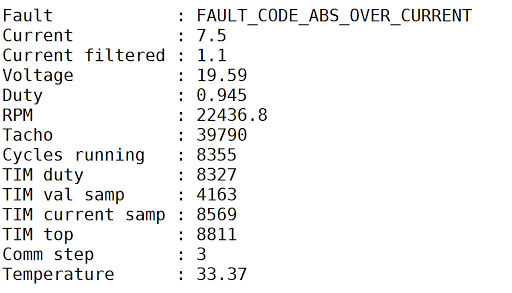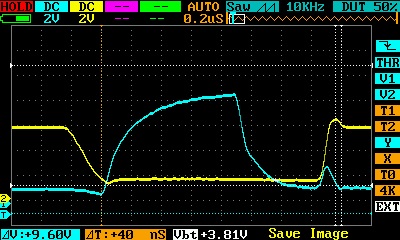So, i got i new DRV of a very friendly member of this forum, thank you a lot. After resoldering i still had some problems due to an unintended bridge.
How is your project going on, Nick?
So, i got i new DRV of a very friendly member of this forum, thank you a lot. After resoldering i still had some problems due to an unintended bridge.
How is your project going on, Nick?
Been learning a lot about the VESC and how it works.
My VESC was losing commutation at high voltage and high current partially because I have too large of current sense resistors, and possibly also too short of a delay after the switching event before the measurement is done (required to get to 95% throttle). The current sense saturates the ADC and it can’t keep track of the values anymore.
Running 95% throttle at 20kHz PWM means there is only 2.5us to sense current, including ~1.5us switching time. Add in some oscillation from switching too hard and an algorithm based on current sense isn’t going to work very well. My single-board VESC is probably going to be limited to 80-90% throttle when we are running 12 or 14S batteries. This is a limitation of the VESC 4.x.
I switched the current sense resistors to 3uOhm, and the VESC seems to run OK on my desk. I’ll get some videos later this week or next week when I finally finish making a dyno. Hopefully I can demonstrate 70A motor current for longer than 2 seconds.
What I have learned (and Vedder has been saying for 2 years) is that there are some major limitations to the VESC4 design:
These issues force you to switch at 40kHz, which then forces you to switch hard, which causes large switching transients. Those transients are probably what keeps exploding the DRV8301’s when you run at 12S. VESC4 makers should put a ferrite bead on the DRV8301 PVDD1. Or slow down the switching with larger gate resistors and increase the layout area to give the fets a chance to dump the extra switching heat. If you have blown a DRV8301 (and I know all of you have) and are putting on a new one, you should cut the trace going to PVDD1 (pin 29) and put a small 0805 or 0603 ferrite bead in there.
https://www.digikey.com/product-detail/en/tdk-corporation/MPZ2012S331AT000/445-1569-1-ND/571899
Even better would be to add the ferrite here, since I’m not sure how much tougher PVDD2 is than PVDD1:
My next board will be a VESC6 with sensing on all 3 phases. It’ll take 5 weeks or so to get the samples in.
Your design is cool! I have tought about making my own design of a Vesc but always postponed it because of the effort. I mostly wanted stronger drivers and more fets which are all on one side for easier cooling.
I would like to add that I seem to have less trouble with my vesc’s drv8302 (that’s the chip the 4.12 vesc uses, the 8301 is for version 6 I think) than others, despite the fact that I have pushed my modified 4.12 vescs to more than 100A with 12S input. I just use good low ESR Capacitors (6 times 460uF currently) very close to the input and I have overvoltage protection diodes across the two largest input voltage ceramic capacitors on the board.
I had the trouble with the current sense resistors, too. The original vesc is limited to +/-160A current sensing and as current peaks exeed this the motor sometimes ‘lost sync’, i.e. suddenly stopped. With currents of about 90A average. I overcame this after @PowerGlider made me aware of my issue with the losses in the 1mOhm sense resistors. I then switched to 0.5mOhm sense resistors, got ±320A mesurement range and this solved my issues.
The packaging of the vesc4.12 is still really bad with added watercooling though.
I made some measurements with 0 current and the DRV8302 is a bit noisy. I measured with oszi in AC a swinging of the outputvoltage of SO1 and SO2 up to 40mV. That corresponds to ± 8A. I can see similar output on the VESC Tool ±5A. I compared with other VESC i have, the never used VESC with default.bin shows ±2A, the heatpipe monster i built shows ±4A with 0.0005.bin on the old BLDC-Tool.
As i am using BLDC mode it should not have dramatic effect on the commutation quality, but only on the current limiting, but maybe i am wrong.
This brings me back to the question, if this shunt measurement with 95% maximum dutycycle is needed at all. In BLDC mode, a single shunt in the supply line could work better. Of course also here some synchronisation is needed, but it should run up to 100%. In BLDC mode you can control the current consumption at high RPM without PWM, just by shifting the phase and would create similar behaviour as field weakening. By this the switching losses could be avoided at most, instead of 20-40kHz you would have something like 400Hz. For our purpose this would be perfect, as the power and current typical increases with RPM dramatically. Additionally we could reach higher RPM with a kind of weak topping with constant power.
This also would ease the requirements for the capacitors lifetime.
In this mode a variable switching frequency would still make sense to minimize switching losses and maximize PWM resolution. Maybe we should adress this in the VESC forum? What ya think?
Are you able to make one that can be rated for 200-300A continuous?
Max, I am working on that right now. Actually the electronics design is done except for sizing the gate resistors, and right at this moment I am deciding if I want to pay extra and wait longer to have the prototypes populated for me. The electrical schematics are VESC6.
Here is my mechanical design concepts of how this fits together. I plan on making it over the next couple months. This design is a two board solution. There is one logic board and 1-4 stackable switching boards.
The switching boards are flat on the back and have screw holes so they can bolt into a cup-like thing that acts as a heat sink to the water outside the thruster.
The assemblage of electronics (1) and heat sinks (2) bolts to a motor adapter (3). The motor leads pass through the adapter and are potted into it, so the motor adapter and motor are permanently connected. The adapter is the seal for the back of the electronics, which can be air filled or oil filled for deep water. The adapter also holds the struts that connect the prop guard/kort nozzle, and it provides surfaces for thrust bearings to push and pull on.
The motor adapter is heavily dependent on the motor. Different motors will need different adapters. The motor shown is an APS C80100 130kv, 7kW motor.
Since the motor runs flooded, the stator will need to be treated with a thick coating of insulating varnish, and the rotor will need a 2 part epoxy based paint.
The propeller is just a placeholder. I haven’t spent the time to model a nice propeller yet. I suspect 7kW is enough power to swing a prop like this: Michigan Match 012008 8-1/4" x 8" 3 Blade RH Propeller - Michigan Wheel 012008 - Evinrude/Johnson 4-40 HP Outboard Propellers - Evinrude/Johnson Outboard Propellers - Outboard Propellers - Propellers - Boatersland Marine
From back to front, the custom made mechanical parts will be:
Mechanical design’s still in a rough state. I haven’t flashed out all the details, but I do have enough to be confident (in my own crazy head) that it is do-able. Once the prototype boards are ordered I’ll have some time to finish out the mechanical details so everyone can see how cool or terrible it looks.
It looks great again and like you have put a lot of tought into it.
If you have a seperate logic board, will you be able to use 2 Layer boards or is it just not worth the hassle?
It looks like it has most of the components on one side. If so I would opt only for the stencil and hot plate solder it. Only if you want to make many prototypes I would endure the additinal waiting for the assambly.
Elaborated Design! http://efoil.builders/uploads/default/original/2X/8/83244bfa1393dc97026b393869a0eb5702197fd1.jpeg
You should design a 90% cover of the all motor openings. This prevents sand inside the motor, so all openings which are standing still should be covered, so only the rotating have small openings. The water passes through the “mill”, the gap between rotor and hub, all heavy particles will be rejected to insert into the motor, only water is allowed.![]()
So the only problem remaining is the circlip to not loose the rotor when braking.
Do you know what the cost of a 300A one of these would be?
@Flo The high power stuff is on the top and bottom layers. It would be cool to do a 2 layer aluminum substrate board, but this layout positioning isn’t super friendly for routing the gate drive wires.
@PowerGlider I’d love to cover the openings. I am going with a “flooded design” because a bunch of ROV/Navy dudes told me that oil-filled, shaft sealed designs are known to fail much more than flooded designs, even when the ROV operates in dirty environments. Perhaps I can put some reticulated filter foam around the stator openings. As long as the motor is spinning and the thruster is moving, the openings on the back of the rotor should be a low pressure zone, sucking clean water through the foam. But how do we put a filter on the crevice between the rotor and the stator?
@maxanderson I’ll be building and testing this board week after next 



 I’ll get some video, and everyone can see if this design can meet their requirements. If it does, then we can put together a group buy to get whatever volume pricing we can get.
I’ll get some video, and everyone can see if this design can meet their requirements. If it does, then we can put together a group buy to get whatever volume pricing we can get.
If people like the ESC design, it would also be good if we can get a group to agree on most-of-the-thruster design, so we can also save money on cnc Aluminum parts like ESC heat sinks, motor adapter, prop adapters, prop guards, etc.
Right, you san seal at the green line and then you suck the water through the red marked slot only. It is not so dramatical. Here i have some details from my design, after it crashed into the beach at high speed, sucking pebbles and sand. Note the marks and scratches. It is still working perfectly, after reglueing the duct to the fin. This is not my end design, i want to experiment with different pitches and this construction is for eased swapping of heavily cut props, so the electric connection does not need to be removed to reach the circlip. I can swap the props without dismounting everything. The drawback is the not perfectly aligned 3D printed spinner.
It would be good to have a design which fits to 63mm outrunners as well.
If the cooling is good, one power board should be enough, 100A*50V is 5kW already, that should be enough for the 63mm outrunners. I also have plans to try 50mm diameter outrunners.
got some data today. Bollard thrust i measured with a digital crane scale https://www.amazon.de/gp/product/B078NSHRST/ref=oh_aui_detailpage_o00_s00?ie=UTF8&psc=1, it was around 30kg.
With a prop of 136mm diameter in a duct, cut down from a 8"pitch yamaha prop, as the picture above.
I did this experiment:
Here’s what I found: If you run at 40kHz sampling, you can see individual humps of current starting from zero, going high, and winding back at zero on each commutation step

Switching at 20kHz, you get half the resolution, and very strange spikes during commutation. Those are probably not real. They could be a digital artifact, but there are definitely big transients and second order oscillation on the o-scope during commutation so who knows. They don’t seem to matter.

Here is a comparison of the oscilloscope and the VESC data (red plot/phase 1):
The commutation spikes don’t seem to affect anything. They happen at the ends of the commutation cycles, are way above the absolute overcurrent threshold, and I think the VESC ignores them. The peaks that happen in the middle of the commutation cycle cause errors. When I turned on the “slow abs current limit” feature, over-current errors happen less, but they still happen. Here is an error that I caused while sampling:

“Current filtered” is 1.1A at the same time the phase currents are touching 7.5A. Instantaneous phase currents are much higher than average motor current. This data is collected at low power, so there could be some noise and some small offset corrupting the data. With high power, I would guess the peak phase currents are around 3-4x the average currents. I haven’t done a sample capture yet with my new high power load setup.
I can confirm your mesurements, my abs max current is also much higher than the avarage max current. I did test this with 80A and it showed twice the max current with the Sampling Feature in the Vesc-tool.
I compiled my own firmware and boosted the abs max current as I have custum cooling that will allow to use higher currents. This removed the Fault_abs_over_current hickups. However I still get sometimes throttled down because of the current peaks, this limits my duty to 75% then. I will have to research this further when my setup is running again. I have no physical explanation for it, at least none that I think is reasonable, but I first experienced those problems when I lengthended my motor wires from ~15cm to 1,5m of 16mm².
And it is possible then to get to higher currents here is a short burst without watercooling of 120A:
On my side with the setup of @pacificmeister I reached 42kg for the Thrust. consumption around 4500w - around 100A (tested in a Pool with a body-scale) - you can see the test in this video : EFOIL Beluga by Fred & Régis | It has taken time, but I finally did it: Efoil plug&play torpedo Many thanks Merten Stroetzel, Carpi Christophe & Nikolai Hiorth for your share and the... | By Frage Against the Machine | Facebook
Even if the measurement was crappy for some reason, i use to look for the input power on my TF02 instrument, and it never exceeds 2.4kW, this happens after a few seconds when reaching top speed normally. This time with the crane scale it was 28-31kg. We did 4 measurements, all had the same result. A week before we recorded 33kg, but that was with a very cheap luggage scale capturing maximum weight. You can barely hold it with two hands and a big handle, sitting on a rack. The amount of water pushing through the duct is enormous. If i had 80A motor current it would be higher bollard thrust…
…maybe we stop the discussion about thrust here, this thread is about custom VESC and the problems arising.
The slow abs current limit is calculated in BLDC mode like this:
// Filter out outliers
if (fabsf(last_current_sample) > (conf->l_abs_current_max * 1.2)) {
last_current_sample = SIGN(last_current_sample) * conf->l_abs_current_max * 1.2;
}
filter_add_sample((float*) current_fir_samples, last_current_sample,
CURR_FIR_TAPS_BITS, (uint32_t*) ¤t_fir_index);
last_current_sample_filtered = filter_run_fir_iteration(
(float*) current_fir_samples, (float*) current_fir_coeffs,
CURR_FIR_TAPS_BITS, current_fir_index);
So, as a first step the outliers are truncated to 120% of the maximum threshold. Than a FIR filter with a length of 16 is implemented. This is rather slow i think. How can it be, that this error is reached at all? I suspect it is an implementation problem or a concept problem, there is something wrong. How can it be, that the control over the current is lost for 16 and even more control cycles? Ok, a commutation happens, how many control cycles is this? one or several? If the commutation happens too early or too late, could this cause the error?
@Flo, what do you miss, when disabling the error reaction at all? General current control is still active i expect.
@PowerGlider are you switching at 20 or 40kHz?
@Flo are you switching at 40kHz or 20kHz when you hit 120A?
I am using BLDC mode with 3-40kHz switching frequency.
Same here, I did not touch the switching code in the firmware. -> BLDC Mode, 3-40kHz switching frequency.
Or is there a way to monitor the current switching frequency directly from the vesc without attaching a scope?
" The current simply becomes noisy and gets aliasing at certain motor phase angles at high speed when using two shunts. " benjamin stated in April this year.
https://vesc-project.com/node/403
Now that he is advertising the improvements gained by 3 shunt design, the weaknesses of HW 4 are discussed in detail.
How is the current measurement working in HW4? Is it measured during the Off-phase of the high side fets, when the low side fets short the current during the remaining 5% (of 95% maximum dutycycle). That would mean that if running with 40kHz, the time window for measuring the current would only be 1.25µs. That fits to the osci picture i already posted 3 weeks ago.

It is around 1.25µs long.
Now for me the question is, if the signal becomes so noisy, will the VESC be able to climb over the 60-80% problem region ever?
“This can be noted on HW4 where a commanded constant current will give a non-linear acceleration: it will be linear to around 60% of full speed, then it will decrease for a bit up to around 80 % and then it will increase from 80% to 100%.”
In the past there was written a lot about motor saturation as an excuse that vesc looses sync, but i do not believe in that, since i got 3.5kW through an APS 6374 with a water cooled YEP 120A without loosing sync.
So, next test will be with Abs over current set to a higher level, this is the solution benjamin spreads through the last year.